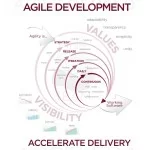Sooner or Later: Deliver Early or Minimize Waste
Later is better than sooner
Lean Development says that in order to avoid waste, we should wait to make decisions as late as possible, especially when we think the stakes may be high. The later that you can make a decision, the more information that you will have on hand to inform your decision, and the more options that you will have to choose from. This means that you should be able to make better quality decisions.
Deferred decision making is built into incremental/iterative planning and management. You don’t try to anticipate everything up front. You don’t try to work out all of the details and dependencies and resourcing at the beginning. Instead, you sketch out an outline of a plan with all of the critical dependencies and milestones that you know about, then focus on what’s in front of you as you move ahead. Detailed decisions about scheduling and implementation and re-prioritization are made when you are ready to do the work, just-in-time.
Deciding later costs less
In Agile Estimating and Planning,Mike Cohn says that “The best way to reduce the cost of change is to implement a feature as late as possible – effectively when there is no more time for change”. Because you are putting off work until later, there’s less chance that new information will come up and force you to change something that you’ve already decided on. Procrastination pays – or, at least, it saves some time and money.
You don’t want to put a lot of work into something until you know as much as you can about what you need to do, how you need to do it, or even if you really do need to do it. Build a prototype or run a technical spike first, build a first-of and maybe a second-of something and get the customer using it, get feedback and make sure you have a good idea of what you are doing before you do more typing. This is good common sense.
And there is other work that you can put off because you don’t have to worry about it – you have to do it, but you know what you need to do and you know that you can do it. You might as well wait until you have fleshed out more of the system first so that you can get it done quickly.
When should you do decide sooner rather than later?
The kind of work that you can afford to put off safely is mostly obvious. And the kind of work that you can’t put off to later is also obvious, like figuring out the basic architecture, the platforms and languages that you are going to use, the basic approach that you are going to follow, proving out your core ideas. These are decisions that you need to make early on, while there is still time to learn and while there is still time to change your mind and start again if you have to.
That’s why I was surprised by the example that Mike Cohn uses in his book: “Adding support for internationalization today may take four weeks of effort; adding it in six months may take six weeks. So we should add it now, right? Maybe. Suppose we spend four weeks and do it now. Over the next six months, we may spend an additional three weeks changing the original implementation based on knowledge gained during that six months. In that case, we would have been better off waiting. Or what if we spend four weeks now and later discover that a simpler and faster implementation would have been adequate?” But internationalization is a cross-cutting concern.
This kind of work is often much harder to take care of than you want it to be or think it will be, impacting more of the design and code than you expect. Do you really want to wait six months before you find out that you have to change all of the forms and reports that you have developed to handle LTR and RTL languages simultaneously, or properly take care of laying out Japanese and Chinese characters? I’ve spent several weeks working with internationalization experts just trying to understand and solve problems with rendering honorific marks in Arabic names (a small thing, but a deal-killer if you are working with Middle Eastern royalty).
Other cross-cutting concerns may require much more fundamental and more expensive changes to implement later, changes that are hard to get right and hard to test: data validation, security, monitoring and instrumentation, caching, logging, error handling, persistence. Understanding this upfront and supporting it from the start is much less risky and less costly than trying to “add it in later”.
When in doubt, sooner is better than later
Deciding to do something early means that you are probably going to make mistakes and you will have to throw some work away, and you’re going to have to make changes later when you get more information. All of this is waste.
When it comes to planning out details, putting off decisions to just-in-time makes sense. But when it comes to designing and implementing important parts of the system, especially technical plumbing and cross-cutting work, doing something sooner is almost always better than later. Managing risk upfront will save you more money in the end.
Reference: Sooner or Later: Deliver Early or Minimize Waste from our JCG partner Jim Bird at the Building Real Software blog.


